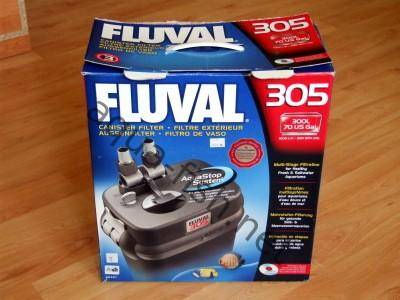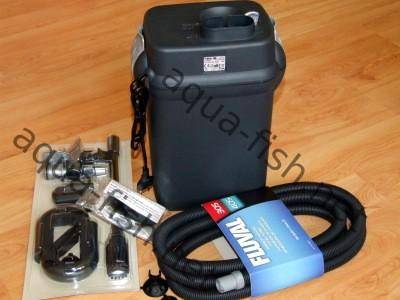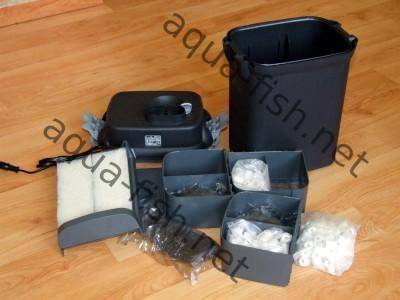Fish Tank: A how-to Guide
Quick links - Answers
Brief Description
This is a guide on setting up a fish tank; With plenty of answers and forum. We'd love to hear your experiences, so once you're finished reading submit your knowledge or questions at the bottom of this page, please!
The first tip: Decide for a fish tank
As we all know, fishkeeping is a hobby and fish are live beings. This is the reason why you must decide wisely following and focusing on a previous research. Fish tanks are usually bought after long solicitous asking by small children. This is not the way how it should be, because your tank crew will be flushed in a toilet sooner or later, usually in a week after starting a tank just for your children or small brother/sister.
So before you buy a tank, ask yourself following questions:
Am I going to take this hobby seriously? Do I know enough about fish species, plants and aquariums in general?
If you’re a beginner and if you answer these questions honestly, you will realise that you don’t know anything or very little about fishkeeping. Basically, this is why I started this post.
The first tip, part one:
Prepare yourself to be helpful for your fish. Prepare for potential troubles which almost every aquarist went through. Prepare yourself for that you will wait months or even years until your aquarium looks as you wish.
Learning is the first aspect of every new activity, so that you must be ready to learn from books, people, or internet.
Rule 1: DO NOT listen to everyone! If you listen to thousand of people, you will hear 100 different tips on one problem for sure. You should find someone who has a nice-looking tank in his home, so that you can take his help seriously. You don’t need any knowledge about diseases, or fish species yet. Just make sure you’re ready for fish.
The first tip, part two:
Go buy some books. Small books can be helpful because they may contain very detailed information on closed topic. Large books seem to be more general, but they usually contain useful information too.
I guarantee you that first point will take you 2 weeks of learning at least.
When you’re done with basic knowledge, you can select place in your home for future aquarium. There are several rules for placing your tank:
- Don’t place it near radiator,
- Don’t place it near window which isn’t isolated enough (old windows),
- Don’t place it near door (thanks to smashing the doors),
- Don’t place it somewhere where the sun shines on it through all the day,
- Don’t hide it, because fish will be shy.
Your tank should be placed like this:
- Stable place,
- Stable temperature,
- Visible all the day,
- All cables and electricity must be visible and accessible for the tank owner (it doesn’t mean that all cables must be visible from ordinary view),
- Fish tank stand must be capable to carry the entire aquarium weight (hundreds of kgs sometimes!),
- You should be able to maintain the tank easily.
After scoring all requirements, you can decide for right place. Consider following things too:
- Will your tank be open/closed?
- Will you use any stand for it?
- How large fish do you want to keep?
I’m going to explain three basic points in order to make you understand everything.
Will your tank be open/closed?
Both, open or closed tanks have their advantages and disadvantages. If you already have an aquarium, you have probably noticed that it sometimes stinks. It’s caused by ammonia, fish excrements, decomposing plants and nearly closed air-circle. According to my description, you can easily realise that I’m talking about closed tanks. Almost every aspect of closed-top tanks makes them handicapped when we compare them to open-top aquariums.
But there are hidden advantages of closed-top tanks naturally. First, no fish will jump out of the tank. Second, temperature is more stable because air carries heat very easily. If there is not enough air to carry the heat, temperature inside of the tank will not vary as easy as in open-top aquariums. However, there is a potential danger interconnected with closed tops; Your tank might overheat during summer periods.
My tank is open-top.
Will you use any stand for it?
Better than ordinary desk, it’s recommended to use prefabricated aquarium stands.
Reason 1: Weight. Ordinary tables aren’t designed to carry 100, 200, 500 kgs of weight. Instead, metal stands are. Generally speaking, there’s no deep discussion about why to use specialized stands. On the other hand, if you have 10 Gallon tank, you can out it on your desk as well.
How large fish do you want to keep?
Fish size is what is "hidden" for many beginners. You go to a shop, but 4-5 small fish, but they will grow by 4-5 centimeters in 4 weeks. This happens almost everytime!
Small fish are recommended for newbies. You don’t need any large and heavy aquarium for small fishes and they’re easy to transport. Moreoverm they don’t eat much.
1 cm of fish = 1 Litre of water in the aquarium. So if you summarize length of all fish except bottom dwellers, you’ll get how large your tank should be, or vice-versa, how much fish you can keep. I found good tool for calculations on this site. Just visit Project/Aquarium calculator.
Filters
We all know two basic types; External and Internal. Each type has advantages, disadvantages. Generally speaking, it doesn’t matter which type you choose. It’s important to choose the most suitable filter.
If you have 100 Litres tank, then a filter for 150 or even 200 Litres tank should be good.
How you should think when selecting the filter:
- Will your tank be planted heavily? If so, you need very powerful filtration.
- Do you plan to let your fish breed? If so, make sure your filter won’t suck the fry and won’t create such water current which doesn’t allow newly born fish to stay in nest.
- Will you be able to buy filtration media? Sounds funny, but market sometimes doesn’t offer you to buy a filtration media! You need to visit another 10-20 shops until you find what you want in such case.
- Don’t buy cheap or used filters.
Fish tank heater
1 - Make sure you need it. If you’re going to breed your fish, you’ll probably need it. 2 - Don’t buy cheap heaters. You must be allowed to put the entire electric cables into water without creating any potential danger.
Bulbs
Bulbs (lighting) are very important for proper fish and plants growth. Too much light results in fast growth, but short lifespan. Too low light doesn’t help plants. Some fish species don’t like when the tank is shiny like summer beaches.
0.3 - 0.5 Watt per 1 Liter is fine in general.
Gravel
Gravel is very important part of each fish tank. Tanks without gravel can be seen in shops mostly. Anyway, if you want to keep plants with roots, gravel (substrate) is necessary.
If your aquarium is 50 cm tall, the gravel should be 5 cm tall at least. 10 cm is optimum. Substrate should be bought in shops only, because various rocks from rivers may contain harmful elements. However, if you want a rocky tank, you’ll need to find some by yourself. I did so and they’re fine. Beware of too much calcium in rocks!
Caves
Caves are natural hiding places for fishes. They should be present in every tank no matter if it’s cichlid, betta, gourami, catfish, cory, etc. tank. Caves help fish to relax, hide if necessary and additionally, they’re helpful during breeding and hatching the fry for some species.
OK, after set-up adding everything into the tank, don’t buy any fish yet. I called this period "acclimatization" even though no-one adapts actually. There are several reasons why to wait before introducing fishes:
1 - Newly set-up aquarium isn’t suitable for living beings. Too much chlorine and labile chemistry is the worst thing you can do for fish or even plants.
2 - Water is usually brown/yellow because of driftwood.
3 - Water temperature is lower than required!!! All newbies check lines below!!!
4 - Aquarium decoration didn’t take it’s final place.
That’s why it’s necessary to wait 1-2 weeks. Running your tank without fish is very helpful because you can improve things like water current by placing the filter at another place, make changes in lighting, install additional heaters, wait until nitrification bacteria reproduce a bit.
Only if tank is ready, go buy some fish. As I mentioned in my previous posts, you must know which fish to buy before you open the shop door. Additionally, you can visit a shop, take pictures of fish and their latin/common names and find into on the web when you return home.
Introducing fish into the fish tank
1 - WAIT until temperature in bag and aquarium gets equal. This means put the bag into aquarium for a while. INTRODUCING FISH INTO WATER WHICH IS TOO COLD OR TOO HOT MIGHT CAUSE THAT FISH WILL DIE!!!
2 - If there are other fish in the tank already, always feed them before you tell them to shake their hands with new fellas. Otherwise they could consider you’re feeding them.
3 - Don’t introduce more than 10 fish at once. This means you should buy 6-7 fish, not more. If everything goes fine after 1-2 weeks from last addition, let’s buy another fish.
4 - If you have 2 tanks, create the quarantine tank from smaller one. You will avoid potential diseases brought from shop.
Now it’s time to plant the tank. Plants should be chosen wisely according to their final size and requirements. Basically, don’t mix plants with different demands on light or water chemistry (pH and water hardness).
Usually, plants should be bought before fish because they create the environment and tank without plants look weird except specific cichlids tanks, etc. So if you’re running a tropical freshwater community aquarium, let’s buy plants before you buy fishes.
Guidelines for plants:
- 1 - As plants grow smaller, they should be placed in front stages. As they grow high, put them to background stages. This means you should know how tall each plant grows.
- Don’t buy too many plants. Every tank is different and what grows nicely in the shop, couldn’t grow at home as well. The best thing is to find some aquarists who have too many plants and get some pieces from them.
- Each plant should be planted well what means roots should be fixed in the gravel. Except floating plants, roots are very important for further growth and reproduction. Some plants reproduce themselves by rhizome, so that proper gravel (fine gravel) and appropriate care is necessary.
- After some time you’ll see if all plants survive. You shouldn’t await all plants to survive; It’s normal that some of them die. In future, you should avoid buying species which don’t like conditions in your aquarium.
- Of course, plants must reproduce. Otherwise it’d be difficult to create a terrific-looking tank. It’s a mistake to think "I’ll buy 100 plants and my tank will look pretty". Rather buy 10 plants instead.
Reproduction of plants
Unlike fish, plants reproduce easily. The best is if plants reproduce by rhizomes or lateral shoots. Plants which grow widely and very fast aren’t recommended for beginners. I recommend you the Anubias species.
Generally speaking, plants reproduction is a subject for another topic and my goal is to make this topic for beginners, not for those who want to reproduce plants.






